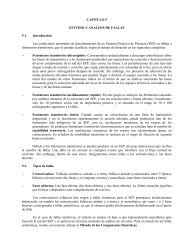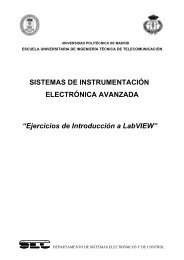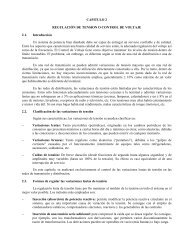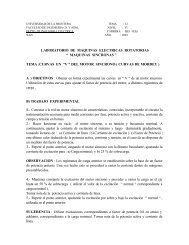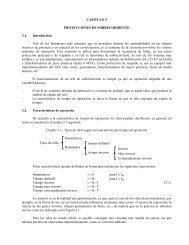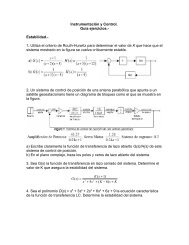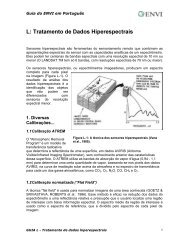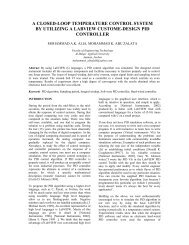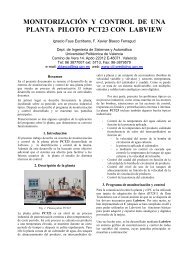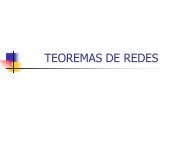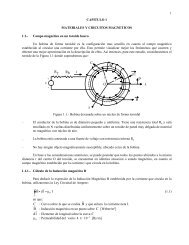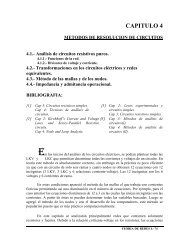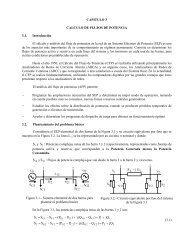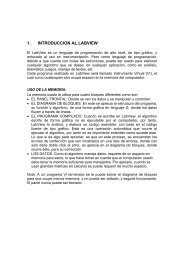T 7.2.1.3 Amplitude Modulation
T 7.2.1.3 Amplitude Modulation
T 7.2.1.3 Amplitude Modulation
Create successful ePaper yourself
Turn your PDF publications into a flip-book with our unique Google optimized e-Paper software.
TPS <strong>7.2.1.3</strong><br />
Solutions<br />
ter suited for the assessment of moduation distortions<br />
than direct display of the modulated signal in<br />
YT modus. Between the modulating and the<br />
modulated signal there arise, e.g. severe phase<br />
delay distortions, if the modulation is performed<br />
using the LP filter connected in series. These visible<br />
distortions on the oscilloscope are frequencydependent.<br />
They belong to the group of linear distortions<br />
and are caused by the phase response of<br />
the electronic components (especially the LP filter).<br />
5.2 Spectrum of the DSB<br />
5.2.1 DSB<br />
Table 5.2.1-1: DSB spectrum<br />
Signal parameter Analyzer settings<br />
A C : 2.0 V V 1 : 2<br />
f C : 20.0 kHz b : 100 Hz<br />
f r : 50 kHz<br />
A M : 2.0 V T : 40 s<br />
f M : 2 kHz<br />
Table 5.2.1-2: DSB spectrum<br />
Signal parameter Analyzer settings<br />
A C : 2.0 V V 1 : 2<br />
f C : 20.0 kHz b : 100 Hz<br />
f r : 50 kHz<br />
A M : 1 V T : 40 s<br />
f M : 3 kHz<br />
Measurements<br />
Theory<br />
Measurements<br />
Theory<br />
V 2<br />
f<br />
KHz<br />
Name<br />
S( n)<br />
V<br />
S AM (n)<br />
V<br />
S AM (n)<br />
V<br />
V 2<br />
f<br />
KHz<br />
Name<br />
S( n)<br />
V<br />
S AM (n)<br />
V<br />
S AM (n)<br />
V<br />
2 18.00 LSL 4,5 1.1 1<br />
2 20.01 carrier 8.5 2.1 2<br />
2 22.01 USL 4.5 1.1 1.00<br />
2 17.00 LSL 2.1 0.52 0.5<br />
2 20.01 carrier 8.4 2.2 2.00<br />
2 23.01 USL 2.2 0.55 0.50<br />
Diagram 5.2.1-1: DSB spectrum<br />
Diagram 5.2.1-2: DSB spectrum<br />
With f M = 3 kHz the frequency of the modulating<br />
signal s M (t) already lies in the cutoff range of the<br />
LP filter. For that reason using a filter can lead to<br />
the attenuation of the amplitude at the modulator<br />
input and thus to a reduction in the modulation<br />
index.<br />
From the spectra it follows that:<br />
– With increasing signal frequency f M the<br />
USLs are shifted away from the carrier in<br />
the direction of higher frequencies. This frequency<br />
response of the USL is called the<br />
normal position, high signal frequencies also<br />
lie in the modulation spectrum at high<br />
frequencies.<br />
– With increasing signal frequency f M the LSLs<br />
shift further away from the carrier into the<br />
lower frequencies. The frequency response<br />
of the LSLs is thus called the inverted position<br />
54



